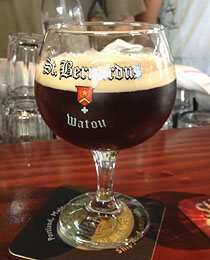 One could easily write a book on this subject and still not have a complete answer to this question. Belgium has a very long, creative, and artisanal brewing tradition that makes it difficult to lump all Belgian beers into a single category. Whereas in Germany, the Reinheitsgebot required brewers to only use barley, water, and hops, there was no such law in Belgium. Brewers in Belgium were allowed to experiment and continue to do so. As a result, there is a huge variety of beers being made in Belgium, and essentially no restrictions on what can go into them.
One could easily write a book on this subject and still not have a complete answer to this question. Belgium has a very long, creative, and artisanal brewing tradition that makes it difficult to lump all Belgian beers into a single category. Whereas in Germany, the Reinheitsgebot required brewers to only use barley, water, and hops, there was no such law in Belgium. Brewers in Belgium were allowed to experiment and continue to do so. As a result, there is a huge variety of beers being made in Belgium, and essentially no restrictions on what can go into them.
That said, there are a few broad characteristics of Belgian beers:
• Belgian yeast strains – Though some Belgian beers (such as Lambics and Saisons) are fermented using spontaneous or “wild” fermentation, most Belgian beers are brewed using very specific yeast strains. Belgian brewers will often ferment these beers at higher temperatures to encourage spicy, fruity, or phenolic flavors and aromas that are produced by stressing the yeasts.
• More malty than hoppy – You’re not likely to find a hop bomb in Belgium (the Belgian IPA is an entirely American construction). Belgian beers are traditionally brewed featuring combinations of wheat, barley, spelt, oats, and other grains.
• Use of spices and herbs – Prior to the widespread use of hops, beers were commonly flavored with a blend of herbs and spices called a gruit. Many of these ingredients survive to this day, the most popular being the coriander/orange peel combination in Witbiers. Saisons also frequently use a variety of spices and herbs.
• Bottle conditioned – Many Belgian beers go through a secondary fermentation in the bottle, which carbonates the beer. As a result, bottled Belgian beers will often have yeast sediment at the bottom. Generally speaking, it’s preferable to leave that sediment behind (despite what Hoegaarden recommends).
Want to brew Belgian beer at home? Try some of these ingredients and brew kits to make your own authentic Belgian-style ales:
Ingredient kits:
• Brewcraft Belgian Wit (White) Bier Recipe Kit – All ingredients are pre-measured and included for brewing this iconic style. Belgian Witbiers are cloudy, pale in color, and flavored with coriander and orange peel.
• Brewcraft Belgian Tripel Recipe Kit – Belgian candi sugar helps raise the alcohol content of this Belgian ale. Look for complex flavors of banana and citrus with a touch of spice.
Yeasts:
• Wyeast 1388: Belgian Strong Ale Yeast – Wyeast 1388 is ideal for strong golden ales. It’s very alcohol-tolerant and finishes dry, fruity, and somewhat acidic.
• Wyeast 3787: Trappist High Gravity Yeast – This yeast is a good all around Belgian yeast strain, featuring a fruity flavor and aroma. This is a very active yeast, so be prepared for high krausen. Tolerant up to about 12% ABV.
Adjuncts and Additives:
• Dark Candi Sugar – This is an invert sugar that helps raise the alcohol content of Belgian ales without adding malt character or body. Also contributes some color. (275º Lovibond)
• Light Candi Sugar – Light candi sugar helps to raise the alcohol content of Belgian ales without adding malt character or body. Unlike the Dark Candi Sugar, this will not add color to your beer.
